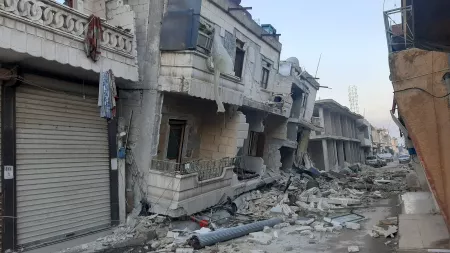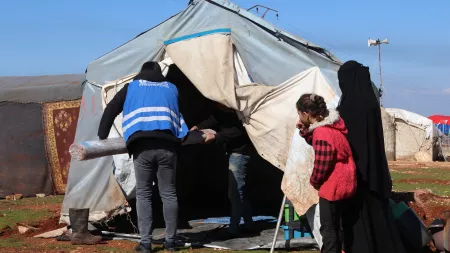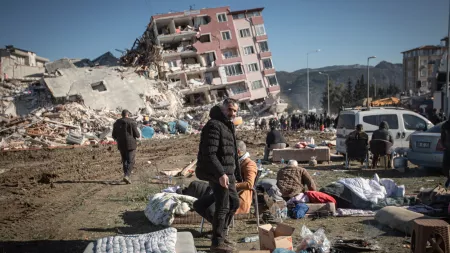More than 50,000 people lost their lives trapped under the rubble, and at least 2.2 million people are now facing homelessness and renewed displacement due to the earthquakes that ripped through south-central Türkiye and parts of northern Syria starting at 4:17am on February 6.
It has been over 80 years since the region witnessed an earthquake of a similar magnitude and devastation.
“Me and approximately 80 percent of [displaced] village residents have sought refuge elsewhere, those who were able to stay inside schools did so; others stayed in their cars, those who had a tarpaulin or a straw mat have sought shelter under the trees,” said Mustafa Abzale, a resident of the Maland village in Idlib.
Today, I do not have the ability to remove the rubble; let alone rebuild [my home]. Today I need bread, and if it weren’t for the help of charity, I could not even buy bread. We left only with our clothes on, the same clothes I’m wearing now.Mustafa Abzale, resident in Idlib, Syria
CARE and partners have responded in some of the hardest hit areas in both Türkiye and Syria, delivering life-saving humanitarian assistance to more than 230,000 people with a total of 363,000 distinct goods or services delivered to help people withstand the blistering cold and find temporary shelter after having lost everything.

CARE and partners have responded in some of the hardest hit areas in both Türkiye and Syria, delivering life-saving humanitarian assistance to more than 230,000 people with a total of 363,000 distinct goods or services delivered to help people withstand the blistering cold and find temporary shelter after having lost everything.
In northwest Syria, nearly 90 percent of the people needed humanitarian assistance prior to the earthquake, and more than 60 percent of the population of 4.6 million are people internally displaced by the 12 year conflict. Approximately 37,000 pregnant mothers will give birth in the next three months and 5,000 will require emergency obstetric care. Meanwhile, 79 percent of people in the hardest hit provinces in Türkiye reported shelter as their greatest need. In Türkiye, around 14 million people live in the 11 provinces affected by the earthquake, 14 percent of whom are Syrian refugees.

A total of 72 metric tons of rice, lentils, bulgur, oil and flour were delivered to various municipalities in Sanliurfa, Gaziantep, Kilis, and Adana, helping bakeries re-open in the wake of the earthquake and community kitchens to serve hot meals to affected communities.
“The needs will keep evolving and as such CARE is working on providing wide-ranging humanitarian relief, with a special focus on supporting the most vulnerable communities,” said Sherine Ibrahim, CARE Türkiye Country Director.
We also must help people, especially women, rebuild their lives and resilience, for example, through small grants that would enable them to re-start their businesses and recoup their hard-won gains.Sherine Ibrahim, CARE Türkiye Country Director
Prior to the earthquake, CARE provided leadership training and small grants to women entrepreneurs in Türkiye to help them establish or expand their businesses. This program will be continued by CARE Türkiye to help local communities, especially women, move beyond the urgency of meeting immediate needs but also restart their business and restore their resilience.
CARE and partners have been working in northwest Syria since 2013 to deliver a wide range of gender-responsive and community-led programs that provide both emergency assistance and longer-term support to both displaced and host communities alike. Programs are focused on emergency cash, voucher and in-kind food and material assistance; water, sanitation and hygiene services targeting the prevention of the outbreak of diseases like cholera; shelter support; sexual and reproductive health services; protection and gender-based violence support; and livelihoods and economic recovery assistance through various initiatives re-engaging local communities in the agricultural sector and offering dignified means of assistance that strengthen women’s abilities to respond to crises.
